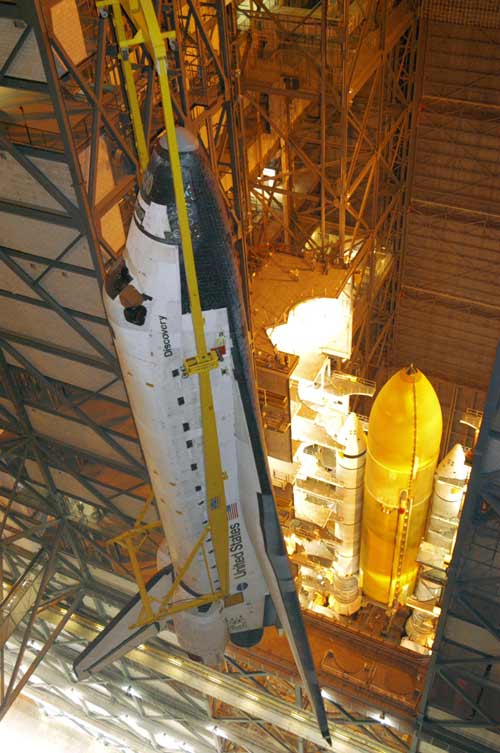NASA Targets Launch Debris Tracking for Discovery's Flight

HOUSTON – NASA officials will tracklaunch debris with more detail than ever before during the liftoff of the spaceshuttle Discovery later this year as the agency pushes to return its orbiterfleet to flight status.
Using radarand more than 100 cameras spread across ground stations and high-altitudeaircraft, flight controllers with NASA’s STS-114 mission aboard Discoveryexpect to get their clearest view of just how much debris separates from the shuttle’sexternal tank in the initial minutes after liftoff.
“We’reexpecting to see more debris than ever before,” said John Muratore, shuttle systems engineering manager, during apress briefing here at Johnson Space Center.
That’snot to say more debris will fall from the orbiter-external tank stack, justthat ground stations will now be able to see more than in the past, he added.
Set tolaunch no earlier than May 15, Discovery will be NASA’s first shuttlemission since the loss of seven astronauts aboard the Columbia orbiter, which broke up duringreentry in 2003 after sustaining critical damage during launch. A chunk of foaminsulation, shaken loose from Columbia’sexternal fuel tank, gouged a hole in the orbiter’s left wing leading edgeand allowed hot gases to seep inside the structure on reentry.
While NASAhas since redesignedexternal tanks to prevent major chunks of foam – like the suitcase-sizedpiece that doomed Columbia– from striking orbiters. But smaller pieces the size of marshmallowscould rain down on Discovery during liftoff and, depending where they strike,cause severe damage or remain relatively harmless.
“Theonly way to really know what’s going to happen in the real world is to gofly,” Muratore said, adding that his team ran through more than one billion computer scenarios and conducted live impacttests to prepare for a safe flight for Discovery. “It’s a verydifficult engineering problem.”
Get the Space.com Newsletter
Breaking space news, the latest updates on rocket launches, skywatching events and more!
Shuttlemission managers are planning to conduct a debris verification review meetinglater this week to discuss the debris risk posed to the STS-114 mission, NASAofficials said.
Radarinstallations placed north and south of Discovery’s launch pad, and anadditional ship-board platform that will observe the shuttle as it passes overthe Atlantic Ocean, were successfully testedlast year during NASA’s launch of the Mercury probe MESSENGER.Meanwhile, engineers are outfitting two WB-57 aircraftwith turret-mounted cameras that will track Discovery’s launch from analtitude of 60,000 feet.
“Ihave a really high level of confidence that if we have any damage on thevehicle, we’re going to be able to detect it,” said John Shannon, shuttleflight operations manager, of the new imaging and radar systems. “I havezero doubt..nothing is goingto get by us. The question is what to do about it then.”
NASA hasspent the last two years trying to develop a set of repair techniques forastronauts to employ in orbit should their shuttle suffer damage to its thermalprotection system of tiles and reinforced carbon carbon(RCC) panels. Discovery will carry materials for some of the five methodscurrently on the table. During the spaceflight, STS-114 mission specialistsStephen Robinson and Soichi Noguchi will test tworepair techniques, including an emittance washapplication for tiles and a caulk-like substance to fill in cracks in RCCpanels.
Discoverymission planners are currently hoping to roll the orbiter, currently attachedto its external tank-solid rocket booster combo, out to its launch pad thisweek.
- Fixing NASA: Continuing Coverage of the Space Shuttle Return to Flight
Join our Space Forums to keep talking space on the latest missions, night sky and more! And if you have a news tip, correction or comment, let us know at: community@space.com.

Tariq is the Editor-in-Chief of Space.com and joined the team in 2001, first as an intern and staff writer, and later as an editor. He covers human spaceflight, exploration and space science, as well as skywatching and entertainment. He became Space.com's Managing Editor in 2009 and Editor-in-Chief in 2019. Before joining Space.com, Tariq was a staff reporter for The Los Angeles Times covering education and city beats in La Habra, Fullerton and Huntington Beach. In October 2022, Tariq received the Harry Kolcum Award for excellence in space reporting from the National Space Club Florida Committee. He is also an Eagle Scout (yes, he has the Space Exploration merit badge) and went to Space Camp four times as a kid and a fifth time as an adult. He has journalism degrees from the University of Southern California and New York University. You can find Tariq at Space.com and as the co-host to the This Week In Space podcast with space historian Rod Pyle on the TWiT network. To see his latest project, you can follow Tariq on Twitter @tariqjmalik.









